LG G2 and MSM8974 Snapdragon 800 - Mini Review
by Brian Klug on September 7, 2013 1:11 AM EST- Posted in
- Smartphones
- LG
- Mobile
- LG G2
- Android 4.2
- MSM8974
- Snapdragon 800
GPU Performance
Snapdragon 800 features Qualcomm's Adreno 330 GPU. Qualcomm hasn't stated publicly how Adreno 330 compares to Adreno 320 featured in Snapdragon 600, but it's almost certainly a larger GPU. The 8974 implementation in LG's G2 clocks the Adreno 330 GPU at a maximum of 450MHz, yet we see better performance than the 450MHz Adreno 320 in Snapdragon 600 - lending credibility to the idea of having more execution resources. There's also an 8974AB variant which includes a 100 MHz bump in GPU clocks up to 550 MHz.
3DMark
3DMark for Android features the Ice Storm benchmark and uses OpenGL ES 2.0. Ice Storm is divided into two graphics tests and a physics test. The first graphics test is geometry heavy while the second test is more pixel shader intensive. The physics test, as you might guess, is CPU bound and multithreaded. The overall score takes into account both graphics and physics tests. The benchmark is rendered to an offscreen buffer at 720p/1080p and then scaled up to the native resolution of the device being tested. This is a very similar approach we've seen by game developers to avoid rendering at native resolution on some of the ultra high resolution tablets. The beauty of 3DMark's approach here is the fact that all results are comparable, regardless of a device's native resolution. The downside is we don't get a good idea of how some of the ultra high resolution tablets would behave with these workloads running at their native (> 1080p) resolutions.
For these benchmarks we stuck with the default presets (720p, normal quality).
3DMark performance generally fell very close to Qualcomm's MSM8974 MDP/T, with one exception. The CPU bound physics tests had the G2 far lower down the list than I would've expected. Given that test is mostly a multithreaded CPU benchmark, it's entirely possible that the G2's thermal/frequency governors are set more conservatively there. The performance gains elsewhere over Snapdragon 600/Adreno 320 are huge, but 3DMark can be very influenced by CPU performance so it's not clear how much of this advantage is due to Adreno 330 or Krait 400.
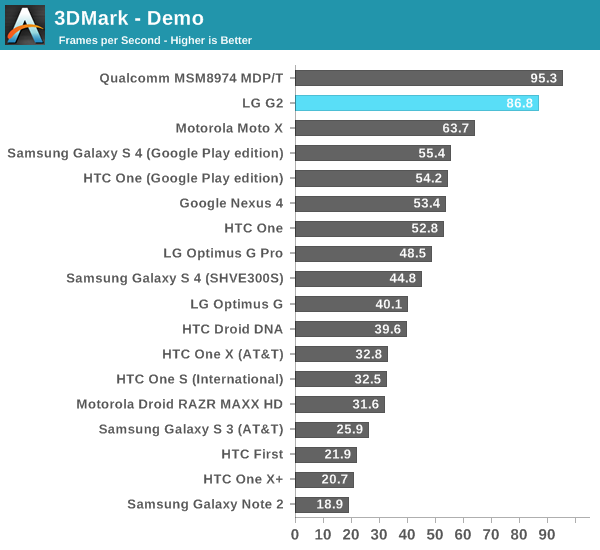
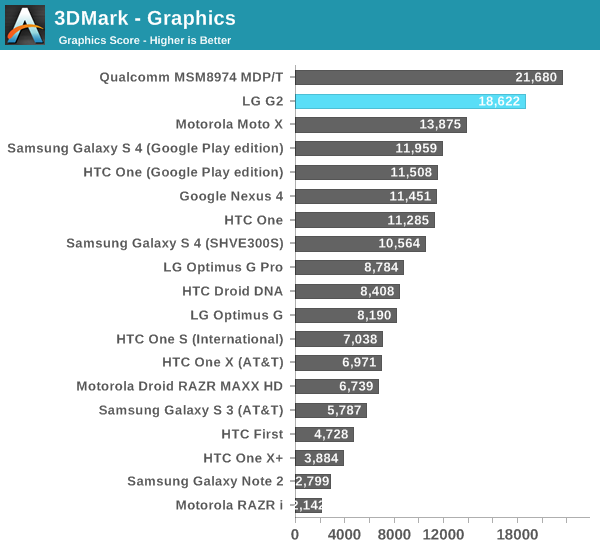
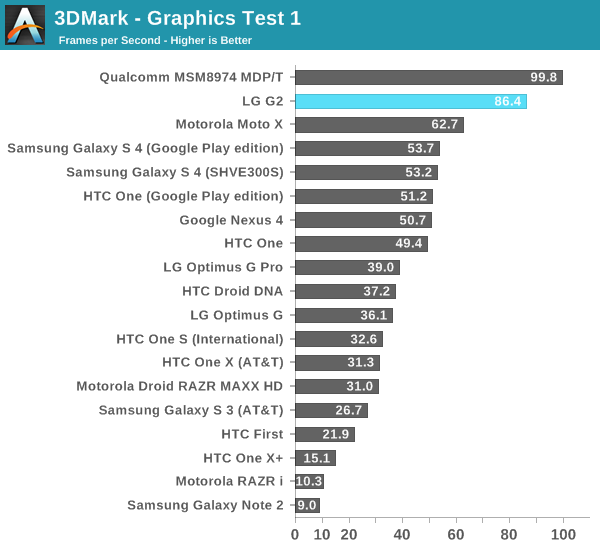
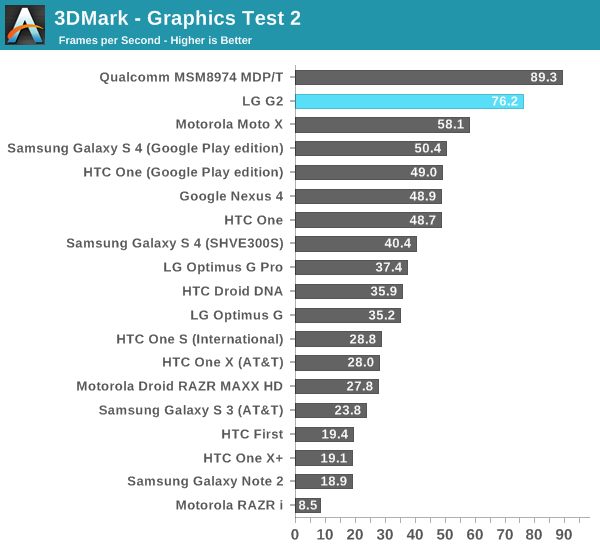
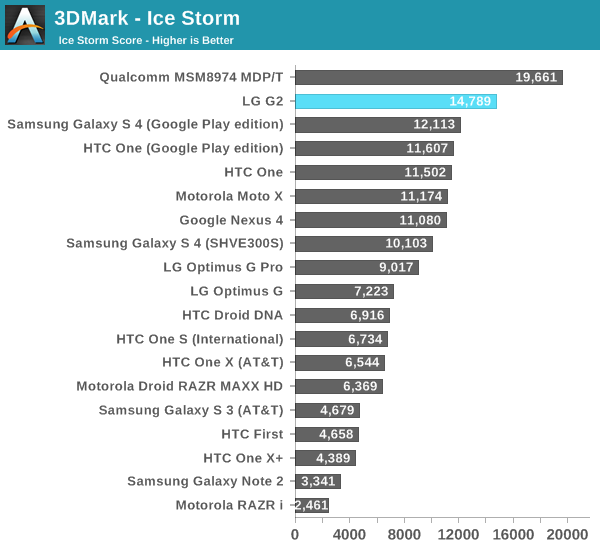
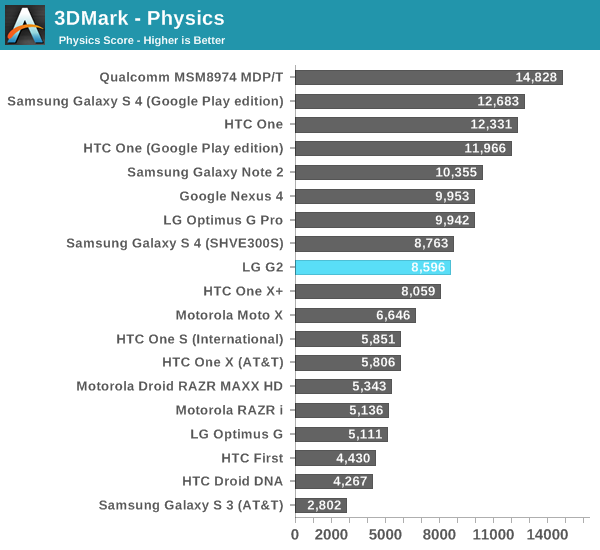
GFXBench 2.7
GFXBench (formerly GLBenchmark) gives us some low level insight into these platforms. As usual, we'll start with the low level tests and move onto the game simulation benchmarks:
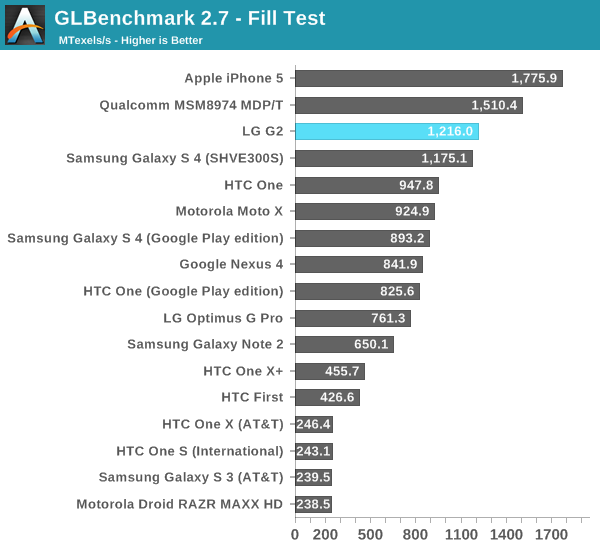
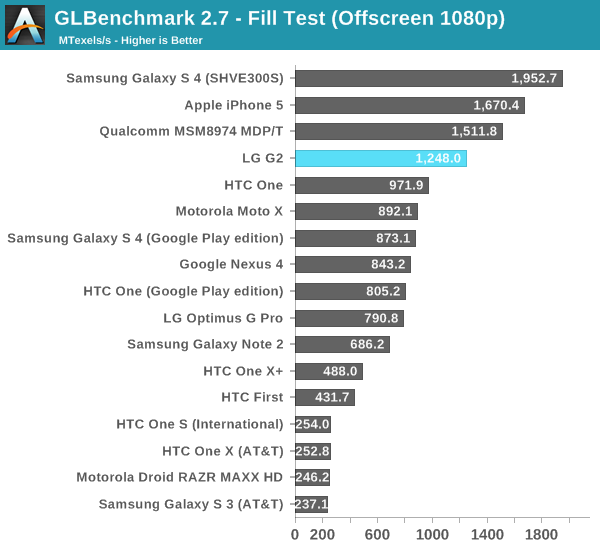
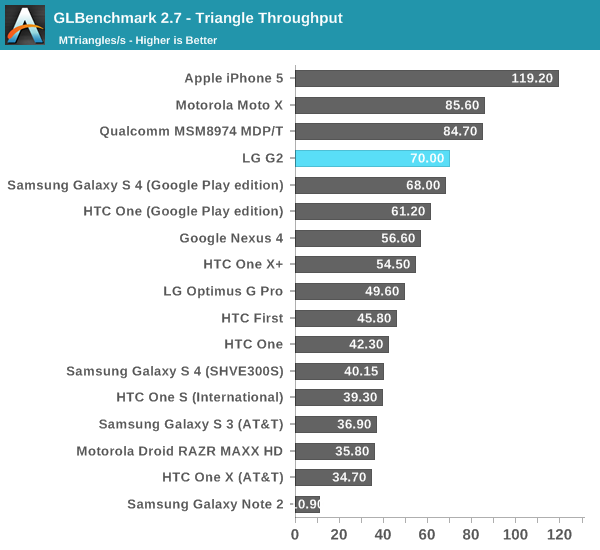
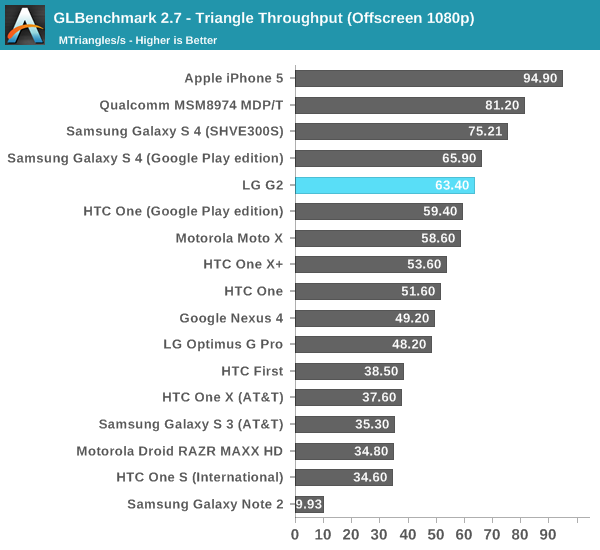
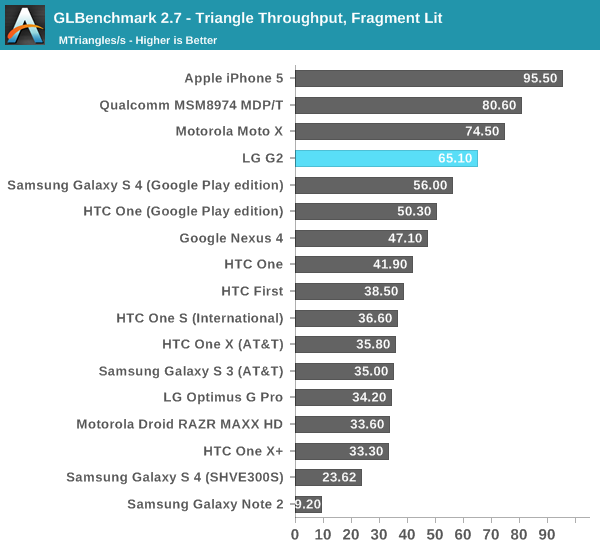
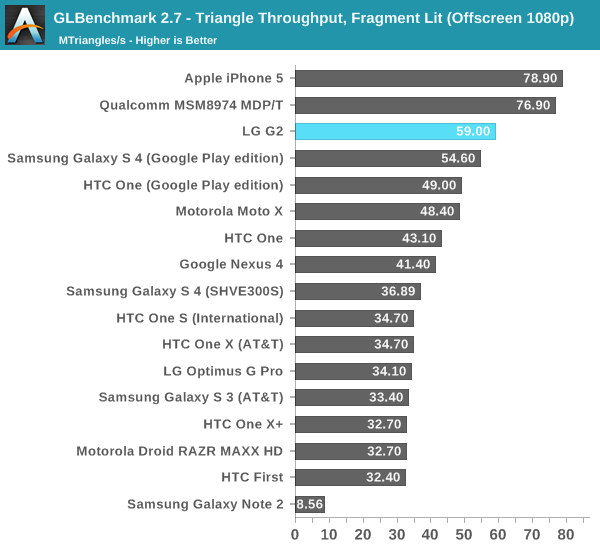
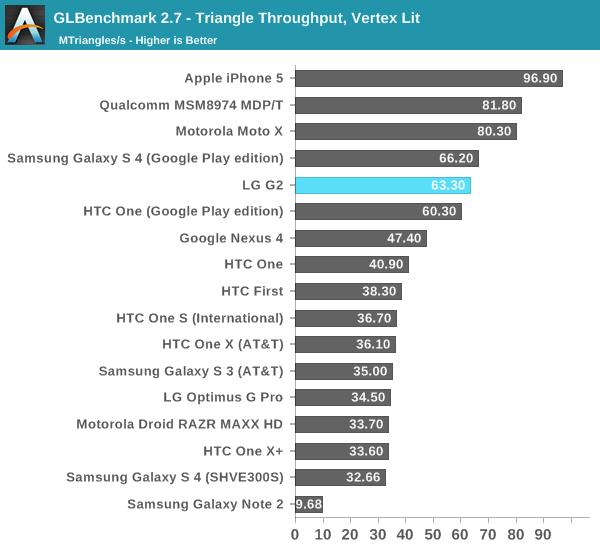
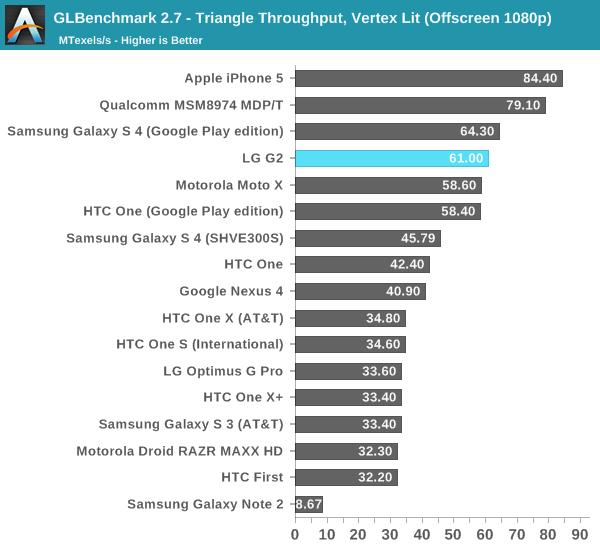
The low level tests put the G2 closer in performance to some of the Snapdragon 600 based devices than the MDP/T, again early software at work here. The T-Rex HD performance looks pretty good, putting the G2 between the S600 devices and S800 MDP/T.
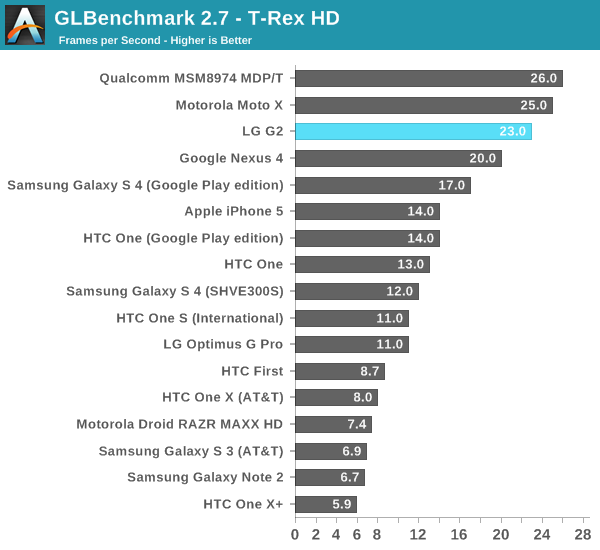
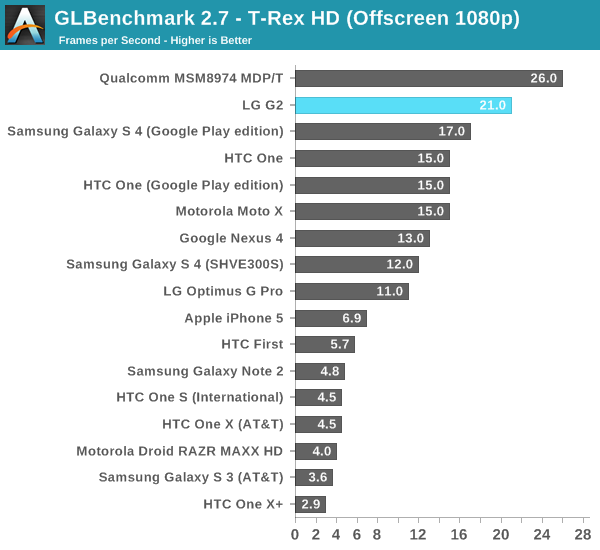
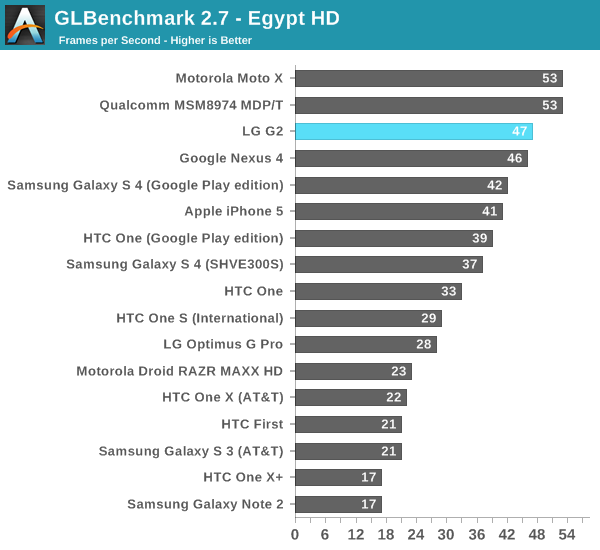
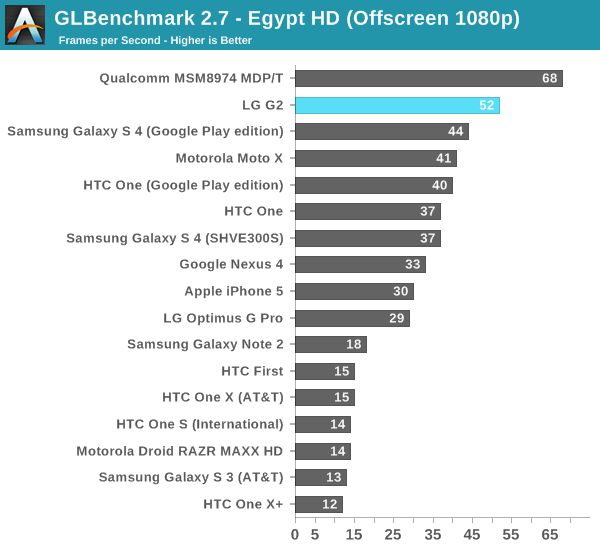
Basemark X
Basemark X is a new addition to our mobile GPU benchmark suite. There are no low level tests here, just some game simulation tests run at both onscreen (device resolution) and offscreen (1080p, no vsync) settings. The scene complexity is far closer to GLBenchmark 2.7 than the new 3DMark Ice Storm benchmark, so frame rates are pretty low:

Basemark X performance tracks with what we saw in the GFXBench T-Rex HD test. Performance is clearly higher than on any other device, but not quite up to MDP/T levels. I wonder how much closer the final device will get.
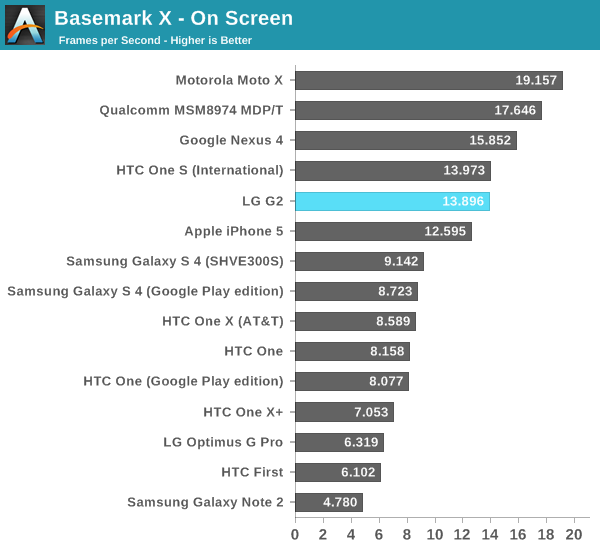
Epic Citadel
Epic's Citadel benchmark gives us a good indication of lighter workload, v-sync limited performance at native resolution. At 1080p, the Snapdragon 800 MDP/T offers over 50% better performance than the Snapdragon 600 based platforms. Granted we're comparing to smartphones here so there's some thermal advantage playing to the 800's favor.
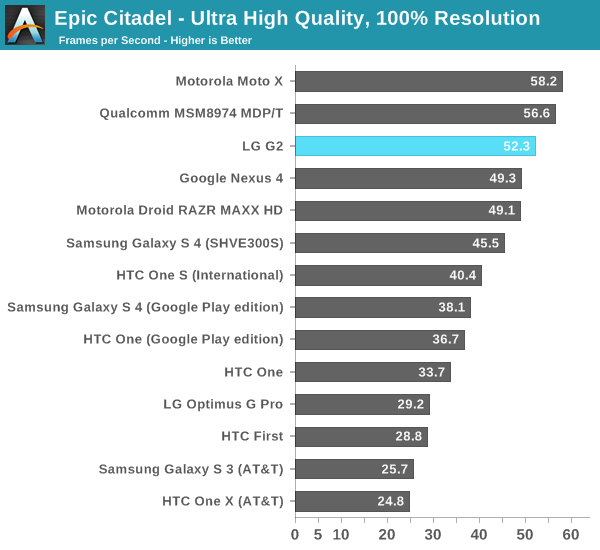










120 Comments
View All Comments
Impulses - Sunday, September 8, 2013 - link
In addition to some of the headphone jack and audio performance someone asked about, a note on speakerphone volume would be nice. I don't think the review even mentioned where it's located (though I'm guessing it's on the bottom edge from the pics I remember glancing at, I wish there wasn't so much click thru required to browse those on mobile btw).Gondalf - Sunday, September 8, 2013 - link
Yes this is a mini review but the battery life benches are pointless. Obviously with a 3Ah battery the Web Browsing result and talk time are very good, considering that the soc is mostly idle or at low clock speeds. No mention about battery life under gaming or other serious usages...this is a pity because the worst defect of these superphones is the very low battery life under stress.I think that Anandtech must to discover the bad side of a device, not only show the points in favor. I have the suspect LG has made an agreement with this web site.
Anyway a so power hungry Soc in a phone is a nonsense that can give many reliability issues to the customers.
Bad review this time, so sorry
Krysto - Sunday, September 8, 2013 - link
That's a good point. I guess the only one that comes close to "real world usage" is the browsing one. Even the video one is not that accurate since it will mainly use the GPU or video accelerator, and you're not going to do video on your phone all the time anyway.tuxRoller - Tuesday, September 10, 2013 - link
Yeah, AT clearly has taken the monies from LG to promote their products.From know on it's going to be 24/7 LG!
coachingjoy - Sunday, September 8, 2013 - link
With a desktop I would think a 2560x1440 display would be warranted.It makes a desktop worthwhile.
I mean, why not use a phone/notebook/laptop instead?
coachingjoy - Sunday, September 8, 2013 - link
ha, my bad. wrong thread.Krysto - Sunday, September 8, 2013 - link
Shocking how good Moto X's EIS was. I wonder if they're using the same stabilization algorithms as the ones Youtube implemented a while ago. It does seem to be about as amazing as that one.Lumia 1020 was definitely the worst. It was jittery through and through.
The order from best to worst was like this
#1 Moto X (virtually perfect)
#2 Lumia 925 (quite smooth, but with some "movements")
#3 HTC One (a little more of those "movements")
#4 LG G2 (not bad, but jittery from time to time)
#5 Galaxy S4 (meh, pretty bad, its EIS doesn't help much)
#6 Lumia 1020 (terrible, almost as if it had no stabilization)
AbbyYen - Sunday, September 8, 2013 - link
is it because MOTO X use dual core 320 so it fare so well compare to 330?ArmedandDangerous - Sunday, September 8, 2013 - link
The HTC One with the newer HBOOT 1.54 has QuickCharge enabled, so it's very much faster than it was at launch now :)Davidjan - Monday, September 9, 2013 - link
Still does not it support OTG? Don't know why it disables power supply for OTG in some module of smartphone like Nexus 4, LG G. If it enable power supply, then can easily extend storage with this mini reader: http://goo.gl/U6IyY